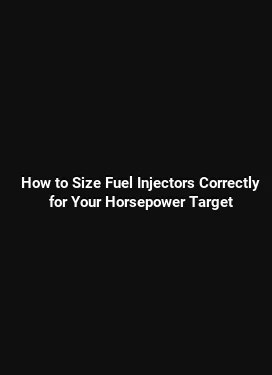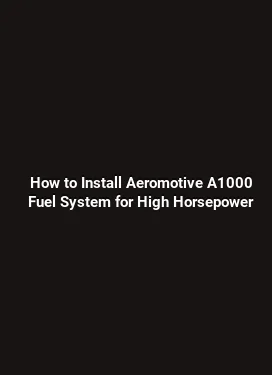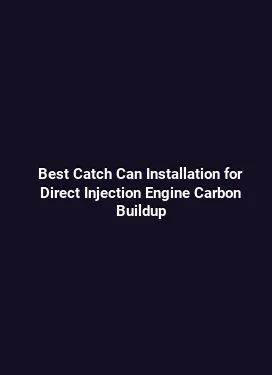Cold Air Intake vs Short Ram Intake: Real Dyno Test Comparison
Intake and fuel system configurations play a pivotal role in how an engine breathes, responds to throttle input, and ultimately delivers power. Two popular aftermarket approaches are the cold air intake and the short ram intake. While both aim to improve air delivery to the combustion chamber, their design philosophies, performance envelopes, and practical implications diverge in meaningful ways. This article dives into real dyno test data, examines the physics behind each setup, and provides actionable guidance for enthusiasts who want to maximize throttle response, mid-range torque, and overall reliability.
How Intake Design Affects Airflow and Power

The fundamental objective of any intake system is to deliver a steady flow of oxygen-rich air with minimal resistance and favorable density. Cold air intakes are typically routed to draw air from outside the engine bay, often via a longer, straighter path to the throttle body. The emphasis is on denser air with lower intake air temperature, which, in theory, yields higher oxygen content per unit volume and greater combustion efficiency at a given manifold pressure.
Short ram intakes, on the other hand, keep the air path compact and close to the engine. They frequently use shorter piping that minimizes plumbing length and pressure drop, aiming to deliver air quickly to the intake valves with less lag. The resulting gains, if any, tend to manifest as improved throttle response and more immediate engine reaction in the lower to mid RPM range, where daily driving and spirited acceleration are most noticeable.
Air Density, Temperature, and Pressure Waves

A key distinction between these approaches is how air temperature interacts with charge density. Cold air is denser than warm air, and colder charge temperatures can increase the mass of air in the cylinder for a given volume. However, the mass flow into the engine is also influenced by intake tract length, runner design, and throttle body size. In practice, a cold air system’s longer path can introduce slight increases in inertial pressure waves that help fill the cylinder at higher rpm, but the benefits depend on the vehicle’s intake manifold, cam profile, and fuel delivery strategy.
Short ram systems minimize renormalization losses from long piping and can reduce intake manifold pressure fluctuations during rapid throttle changes. The result may be a more immediate but sometimes less sustained power delivery, particularly if the vehicle is tuned for a higher air charge temperature or if the intake path constrains peak charge delivery at higher RPMs.
What Each System Measures: Temperature, Velocity, and Tuning
Evaluating an intake system requires looking beyond simple horsepower numbers. Real dyno testing considers air temperature at the intake, air velocity through the entrance, and how the system interacts with the engine’s control strategy. In dyno runs, cold air intakes may show a modest horsepower gain at peak RPM if the ambient conditions support lower intake temperatures and if the engine can sustain higher air density under boost or high-load conditions. Short ram configurations often exhibit a more linear torque curve with quicker throttle response, especially in naturally aspirated engines or mildly boosted setups.
Several practical metrics help quantify performance differences without relying solely on peak numbers. These include: throttle response time (time from pedal input to noticeable engine response), mid-range torque consistency across gears, and the system’s behavior under heat soak. It’s common to observe that cold air setups provide gains in sustained high-RPM runs under controlled dyno conditions, while short ram systems deliver repeatable, repeatable gains in the vehicle’s daily driving window where temperatures are variable and fuel trims are continuously adapting.
Fuel Trims and Air-Fuel Ratio Management
Intake system choice does not operate in isolation. Modern engines rely on precise fuel metering to maintain air-fuel ratios that optimize power and efficiency. When an intake design alters the charge temperature or density, the engine management system may adjust fueling to compensate. In dyno sessions, this can manifest as slight fluctuations in fuel trims across test runs. A well-matched intake and a proper calibration tune will ensure that air-fuel ratios remain within the target band across the operating range, preserving reliability and minimizing knock or pre-ignition risks.
For street use, the tolerance for minor trims can be acceptable, but for track or aggressive street driving, verifying that the intake works harmoniously with the ECU map is essential. Some vehicles benefit from a tune that adapts timing and fueling to the specific intake’s characteristics, while others perform adequately with factory calibration and a conservative fuel strategy.
Dyno Testing Methodology and Variables
Reliable dyno comparisons require a controlled approach. The following elements are typically considered when contrasting cold air and short ram intakes:
- Same vehicle baseline configuration: identical exhaust, drivetrain, and ECU software state, with only the intake system changed.
- Consistent environmental conditions: stable ambient temperature and humidity to minimize air density fluctuations.
- Warm-up protocol: ensuring the engine reaches operating temperature to reflect real-world conditions before data collection.
- Multiple runs per configuration: to average out transient variances and verify repeatability.
- Measurement of power and torque across a broad RPM range: not just peak figures but the entire curve to identify throttle response characteristics and where gains occur.
In practice, dyno data often reveals that cold air intakes provide a small peak gain at higher RPMs under stable testing conditions, while short ram intakes show a more pronounced response in lower to mid-range rpm. However, the magnitude of these effects is highly dependent on engine displacement, cam timing, compression ratio, and whether the engine operates in naturally aspirated or forced induction modes.
Heat Management and Intake Positioning
Heat soak is a critical factor for any intake system. Cold air intakes rely on an external air path that guards against ambient heat from the engine bay, but the intake’s proximity to heat sources and the integrity of the ducting influence actual temperatures reached by the charge. Short ram systems are typically located within a hotter zone of the engine bay, which can raise intake air temperatures after a prolonged idle or during heavy winter loading conditions. Dyno comparisons often show occasional efficiency benefits for cold air systems in hot climates or during sustained high-load testing, yet in cool ambient conditions, the difference may be negligible for everyday driving.
Engine bay airflow dynamics, including radiator fan activity, bumper design, and hood scoops, can alter the cooling effect and air velocity entering the intake. Real-world testing sometimes demonstrates that a well-designed short ram with quality filtration and a properly sealed intake path can minimize stray heat pickup while preserving a lively throttle feel.
Practical Considerations for Install and Reliability
Deciding between cold air and short ram involves more than peak dyno numbers. Installation complexity, filter serviceability, and long-term reliability are key factors that influence the real-world usefulness of each system. Cold air intakes usually require larger, more rigid mounting points and a longer, straighter air path. They may also demand careful routing to avoid interference with moving components, under-hood heat sources, and moisture ingress in wet climates.
Short ram systems typically offer easier installation with shorter tubing and fewer components to route. The filter sits closer to the engine, which can simplify maintenance but may expose the filter to higher heat exposure. The choice often hinges on the vehicle’s layout, the owner’s willingness to manage heat-related performance, and the intended driving profile, whether daily commuting, weekend canyon runs, or track duty.
Filter Quality and Filtration Efficiency
Regardless of the intake path, the quality of the filter media and the seal integrity are essential. A high-flow filter with effective sealing reduces the risk of unfiltered air entering the intake tract, which can cause wear on intake valves and enhanced engine deposits over time. When evaluating filters, consider metrics such as initial filtration efficiency, dust-holding capacity, and ease of cleaning or replacement. The filter’s shape and orientation can also influence how debris is captured and how evenly air is distributed across the filter surface.
A well-designed filtration system minimizes pressure drop while maintaining adequate filtration performance, which is crucial for consistent power delivery and engine longevity under dynamic loads.
Real World Scenarios: Power Delivery and Driveability
Kurated tests and owner reports often reveal that the perceived benefit of either system is highly context-dependent. In a daily driving scenario with moderate climate and standard city traffic, the difference between a cold air and a short ram intake can be subtle, with driveability and throttle response being the primary differentiators. In performance-focused conditions, such as track sessions or hot weather, the cold air intake may deliver measurable gains at high RPM if heat soak is mitigated and the engine is tuned to exploit increased air density.
On the other hand, a short ram intake can offer a more immediate “hook” feel when the throttle is pressed, producing a more linear response that many drivers associate with a more energetic engine note and a quicker response to pedal input. For vehicles that already have a high-revving nature or aggressive cam timing, these effects can manifest as a more responsive, sportier driving experience without requiring a significant ECU adjustment.
Vehicle-Specific Considerations
Engine architecture, intake manifold design, and cylinder head flow characteristics influence how much benefit an intake upgrade provides. For engines with restrictive stock intake runners or less efficient air paths, both cold air and short ram modifications can unlock untapped potential. Conversely, engines that already breathe efficiently through stock components may see diminishing returns with aftermarket intakes, particularly if the rest of the hardware and map are not optimized to take advantage of the improved airflow.
Additionally, compatibility with other performance parts, such as exhaust systems, intake manifolds, and forced induction components, determines whether an upgrade yields synergistic gains. A balanced approach that considers the whole induction and fueling system tends to deliver more meaningful results than a standalone modification.
Maintenance, Durability, and Longevity
Maintenance considerations should be part of the decision-making process. Cold air induction paths may accumulate moisture during heavy rain or flood-prone conditions, necessitating protective sealing and robust filter housings. Short ram systems often have simpler cleaning routines and filter replacement intervals due to the compact layout, but the higher temperature exposure can accelerate filter media degradation if the fuel and oil vapors in the engine bay degrade filtration efficiency over time.
Regular inspection of clamps, couplers, and mass air flow sensors is advisable. A secure, well-sealed system helps ensure consistent performance and reduces the risk of vacuum leaks, which can undermine power delivery and driveability despite upfront gains observed on a dyno chart.
Summary of Practical Outcomes
When choosing between cold air and short ram intakes, consider the following practical takeaways: Cold air systems can offer benefits in dense air conditions with well-managed heat soak and appropriate tuning, delivering potential peak gains at higher RPMs. Short ram systems typically provide quicker throttle response and a more linear power delivery in everyday driving, with gains that can be more noticeable in the mid-range. The actual impact depends on vehicle-specific architecture, climate, and how the engine is tuned to the intake characteristics. Thorough testing on a controlled dyno, combined with real-world driving data, helps align expectations with measurable performance outcomes.
Installation and Tuning Checklist
- Verify fitment with engine bay geometry and avoid clearance issues with hood, intercooler piping, and belts.
- Assess heat shield effectiveness and route length of intake tubes to minimize heat transfer.
- Ensure filter and housing are sealed properly to prevent unfiltered air ingress.
- Perform a baseline dyno run, then test both configurations with multiple runs under the same conditions.
- Evaluate air-fuel management and readiness for any ECU recalibration if needed.
Ultimately, the choice between cold air and short ram comes down to how a specific vehicle responds to the change under real-world driving and how much emphasis is placed on peak power versus throttle feel and reliability.






